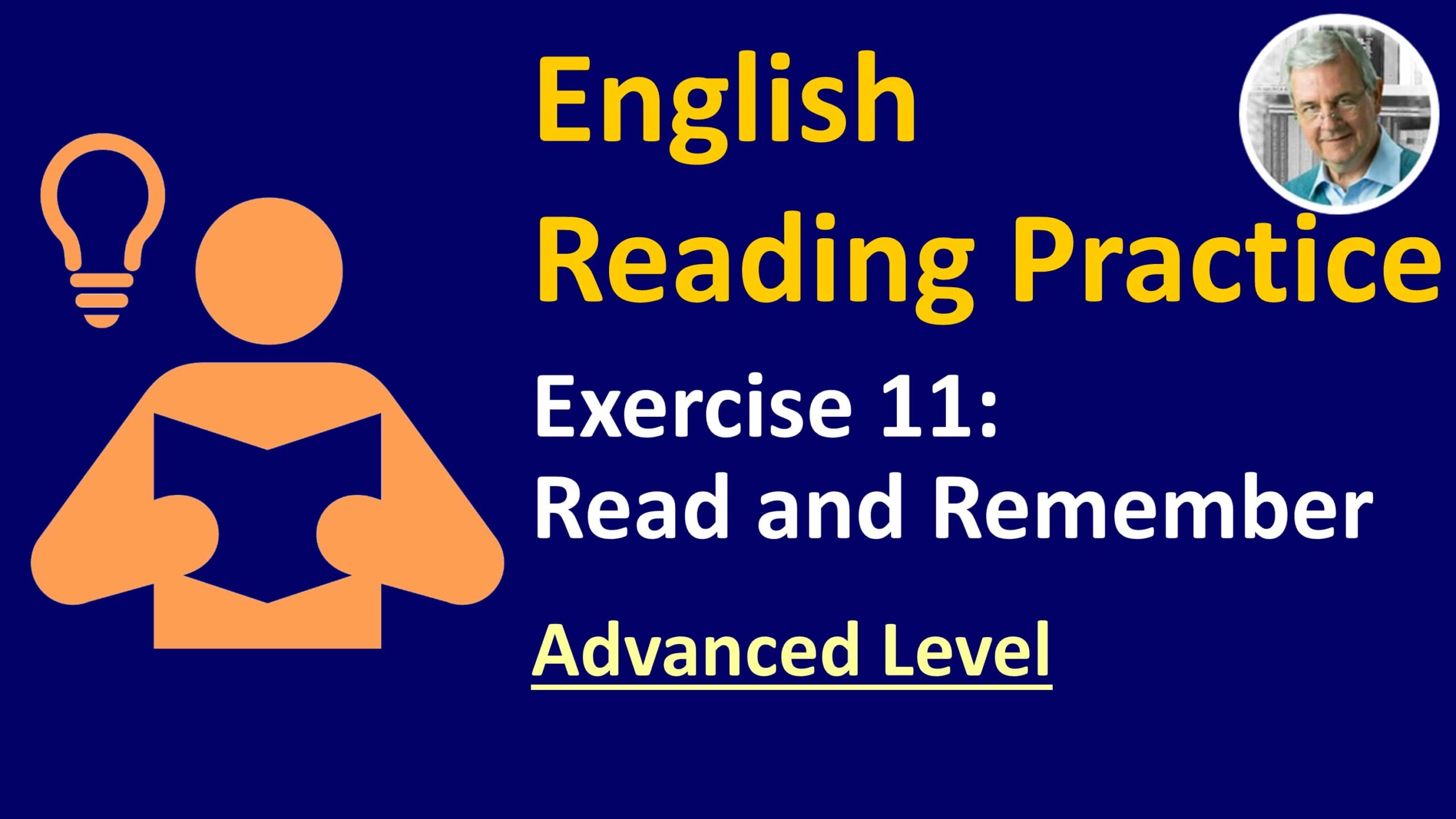ENGLISH Reading Exercise #11 (Intermediate)
ENGLISH Reading Exercise #11 (Intermediate): Read and Remember
Click Here for ENGLISH READING PRACTICE EXERCISES
This English reading exercise has been created for English students who are at a beginner to intermediate level. The pace of the reading is slower, with emphasis on pronouncing all the syllables.
During this English reading practice session, you will read along with the teacher at the same time, with the teacher’s voice superimposed over their own, students start to self-correct in the areas of pronunciation and fluency, learning to read and speak in natural word groups.
After a student feels comfortable at this pace, they can do the exercise created for intermediate to advanced students, which is faster and sounds normal for a native speaker.
English reading practice will certainly help you speak English fluently or at least great improve your English fluency.
Be sure to watch the introductory video to this playlist before doing this exercise.
Click on the link below in the Description . . .
(https://youtu.be/IOeaBha6dUU)
Instructions
- Turn up the volume so the teacher’s voice is loud.
- Read the words in red out loud at the same time as the teacher.
- Pay attention to the teacher’s voice intonation and the word groups.
- If you find the speed is too slow, go to the playlist and choose the advanced version.
The text:
How to Read and Remember
Would you like to remember more of what you read? Then you will be interested in the work of Francis Pleasant Robinson, an educational psychologist. In 1946 he published a book entitled: “Effective Study” which outlined a reading method called SQ3R. This acronym stands for 5 steps:
Survey
Question
Read
Recite
Review
In addition to reading being an eye activity, it is also a brain activity. To make each reading period a truly productive learning process, learn to stimulate the brain to ensure reading is an active, not a passive, process. The SQ3R method does just that. Let’s examine each of the stages.
Step 1: Survey
Spend just a few minutes browsing the article or chapter and get a feel for the direction and objective of the material. Pay attention to the title, headings and subheadings, the first and last paragraphs, pictures, diagrams and captions, and any words in italic or bold emphasis. By doing this your brain starts to organize immediately and anticipates what is to come.
Step 2: Question
After surveying the material and BEFORE you start to read, spend just a few moments formulating questions you expect to have answered in the material. You can do this by making a question out of the title or sub-heading.
This step is essential in increasing your concentration and helping you read with a purpose. Many find it helpful to write down the questions they expect to have answered.
Step 3: Read
With this preparation complete, start the active reading process. Mark the text as you read, underlining or color highlighting key words and phrases. Make notes in the margin when you discover the answers to the questions you previously raised. Just read a section at a time and re-read difficult passages.
Step 4: Recite
Imagine you have to give a brief summary of what you just read to a friend next to you. Orally express the main ideas or use your own words to answer the questions you raised in step 2.
What you read makes a much deeper impression on the brain when you see it, say it, and hear it. If you write it as well by making brief notes encapsulating the key ideas, you employ a fourfold method of emphasis.
Step 5: Review
Make notes, flashcards, or diagrams on the main points of the material and review them the next day, the next week, and the next month so the information goes into long-term memory.
At first glance the SQ3R method appears to involve a lot of time and effort. In practice, the opposite is true. Most of the steps, apart from the actual reading, take just a few minutes.
Ask yourself, “What takes longer, reading material most of which I forget shortly afterwards requiring that I re-read it or adding a few minutes on to the reading session so that I can easily recall from memory most of what I read?”
Repetition REALLY IS The Mother of Retention
As with any skill, time, energy, perseverance and determination are needed to develop it.
A person may devote many hours to learning a new game, or recreational activity. Considering how important reading is, the time and effort needed to practice and employ the methods outlined above will yield far more valuable rewards.
That is the end of the reading.
Repeat this exercise many times until you can synchronize your reading with the teacher.
Practice other exercises in this playlist and see a major improvement in your English speaking fluency.
Has this video helped you? Hit LIKE now!
Continually IMPROVE YOUR ENGLISH by subscribing to this channel.
Hit the subscribe button NOW!
Click the bell icon and choose All to be notified when there are new videos!
Build A Powerful English Vocabulary with my FREE course on Udemy.
Go to: http://goodenglish.online
If you found this English Practice Reading Exercise helpful, be sure to check Exercise 7 (Intermediate) which provides helpful information on thinking patterns
ENGLISH Reading Exercise #10 (Intermediate): Questions


